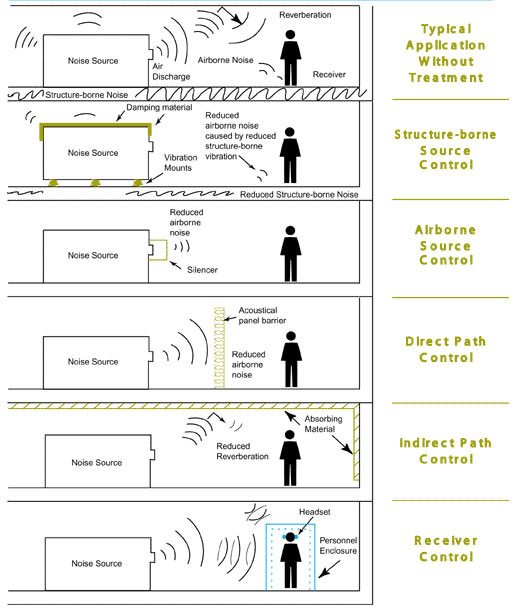Noise Control Treatment Strategies
Fundamentals Of Noise Control Problem Solving
Effective acoustical design in the Industrial, OEM, HVAC, Architectural and Environmental markets relates to the simple Source/Path/Receiver model. In most cases the simple model is more complex as there are multiple sources generating the noise, multiple transmission paths and multiple receivers or receiver areas that are targeted for noise control. Furthermore, the source can be airborne and/or structure-borne and the transmission path can be direct and/or indirect (reflected). Each of these areas in the noise control model need to be evaluated to determine where the simplest most cost-effective treatment can be applied while meeting all of the project requirements. Important factors in addition to the overall acoustic performance include cost, safety, accessibility, visual access, ease of installation, useful life, aesthetics and minimizing the disruption of daily operation of the process, system or equipment. The sketches and descriptions on the next page will illustrate in more detail the most basic treatment strategies using engineering controls.Please note that prior to implementing noise control treatments, mechanical equipment should be checked for proper installation, balancing and routine maintenance. Poorly maintained equipment will generate higher noise levels.
Proper selection and sizing of equipment or modifications to the operating speeds should also be reviewed prior to instituting engineering controls. Slower operating speeds will generally result in lower noise levels.
In end user applications, administrative controls can reduce employee/receiver noise dose/exposure. This is done by limiting the daily duration of operation for noisy equipment or time shifting employees to bring down the overall time weighted average.
Source/Path/Receiver Model
The sketches and descriptions below illustrate in more detail the most basic treatment strategies using engineering controls. "Typical" noise reductions associated with each strategy are listed below.
| SOURCE CONTROL | DIRECT PATH CONTROL | INDIRECT PATH CONTROL | RECEIVER CONTROL |
|---|---|---|---|
| 6 to 8 dB | 10 to 25 dB & up | 4 to 6 dB | 10 to 25 dB & up |


